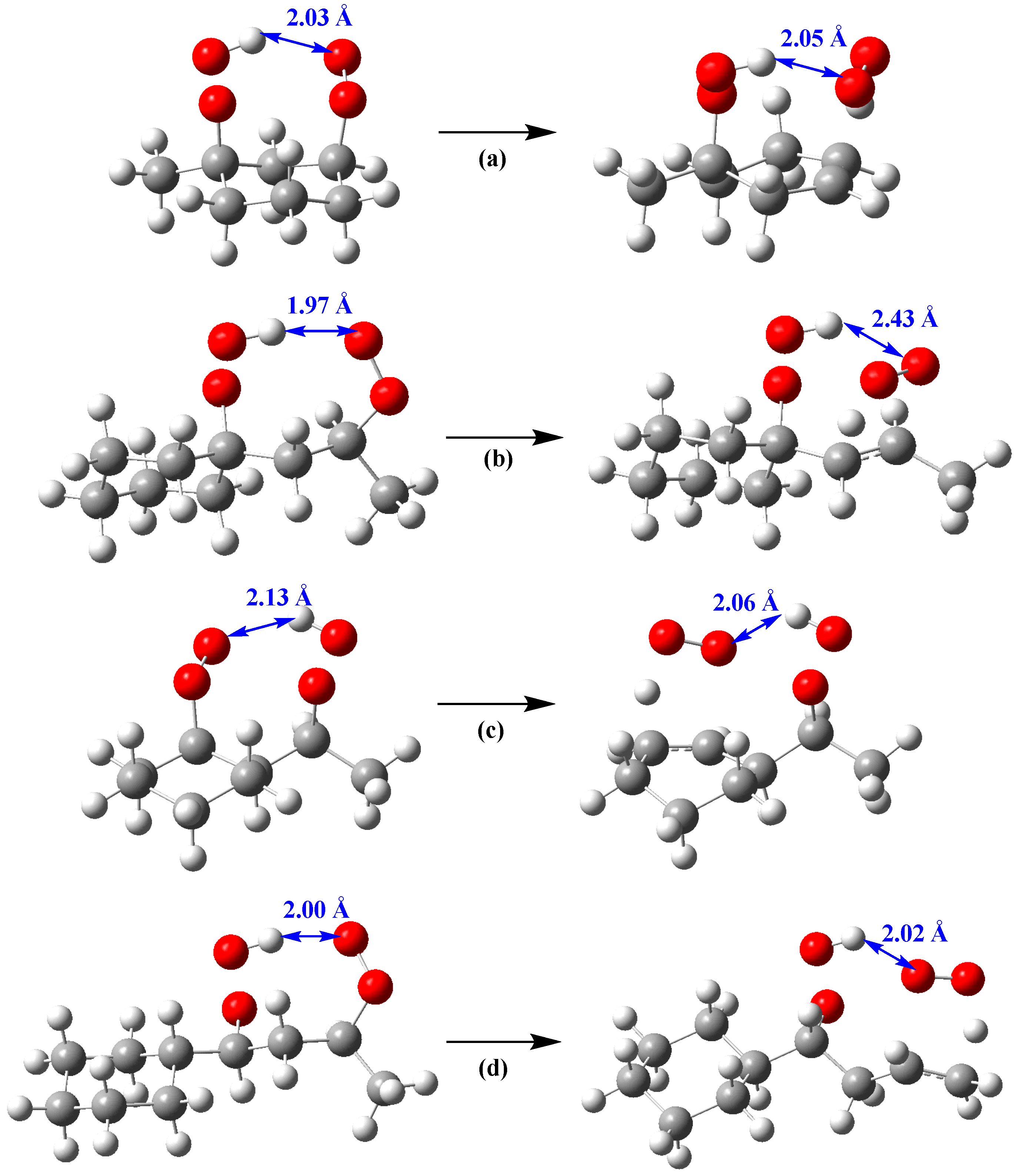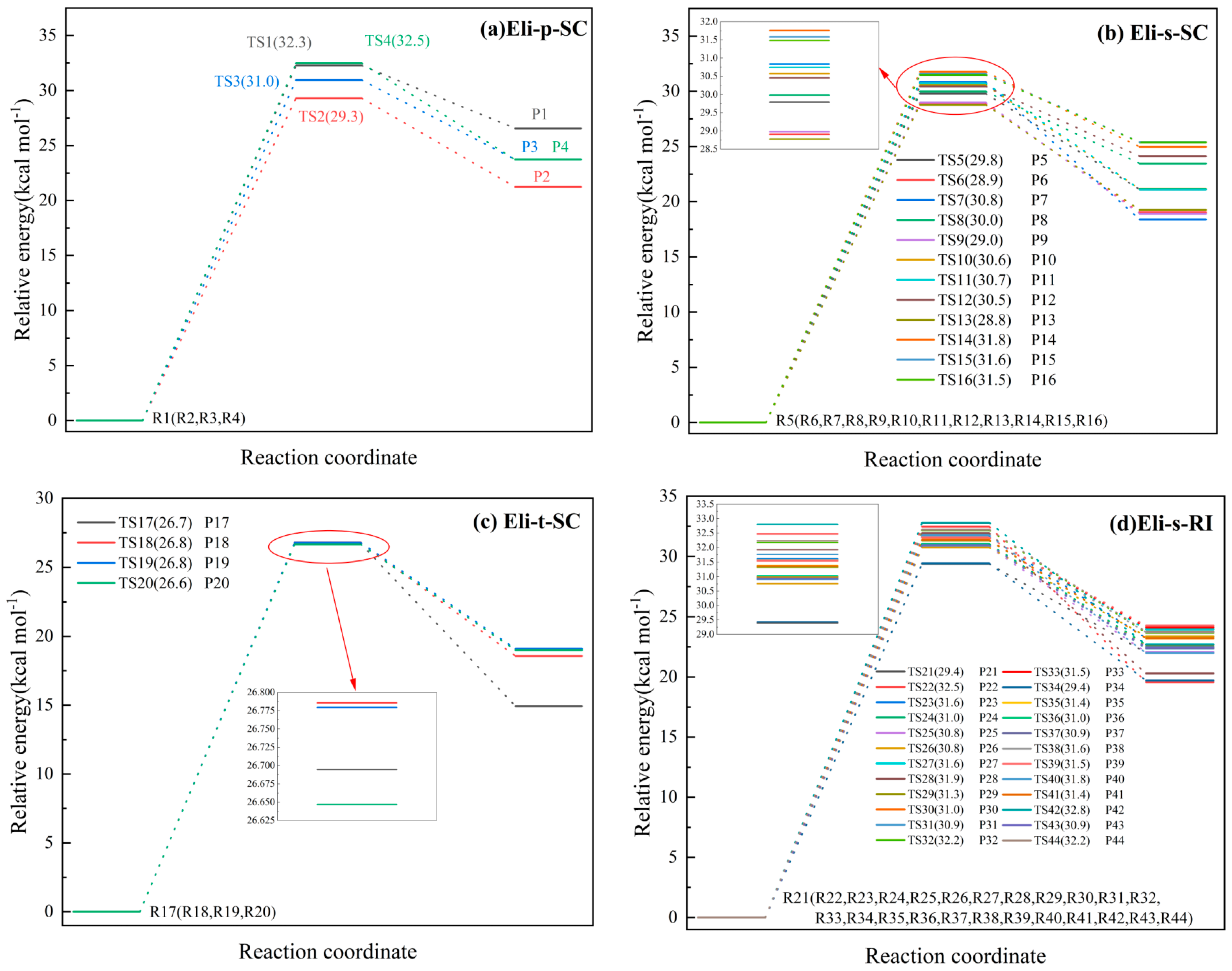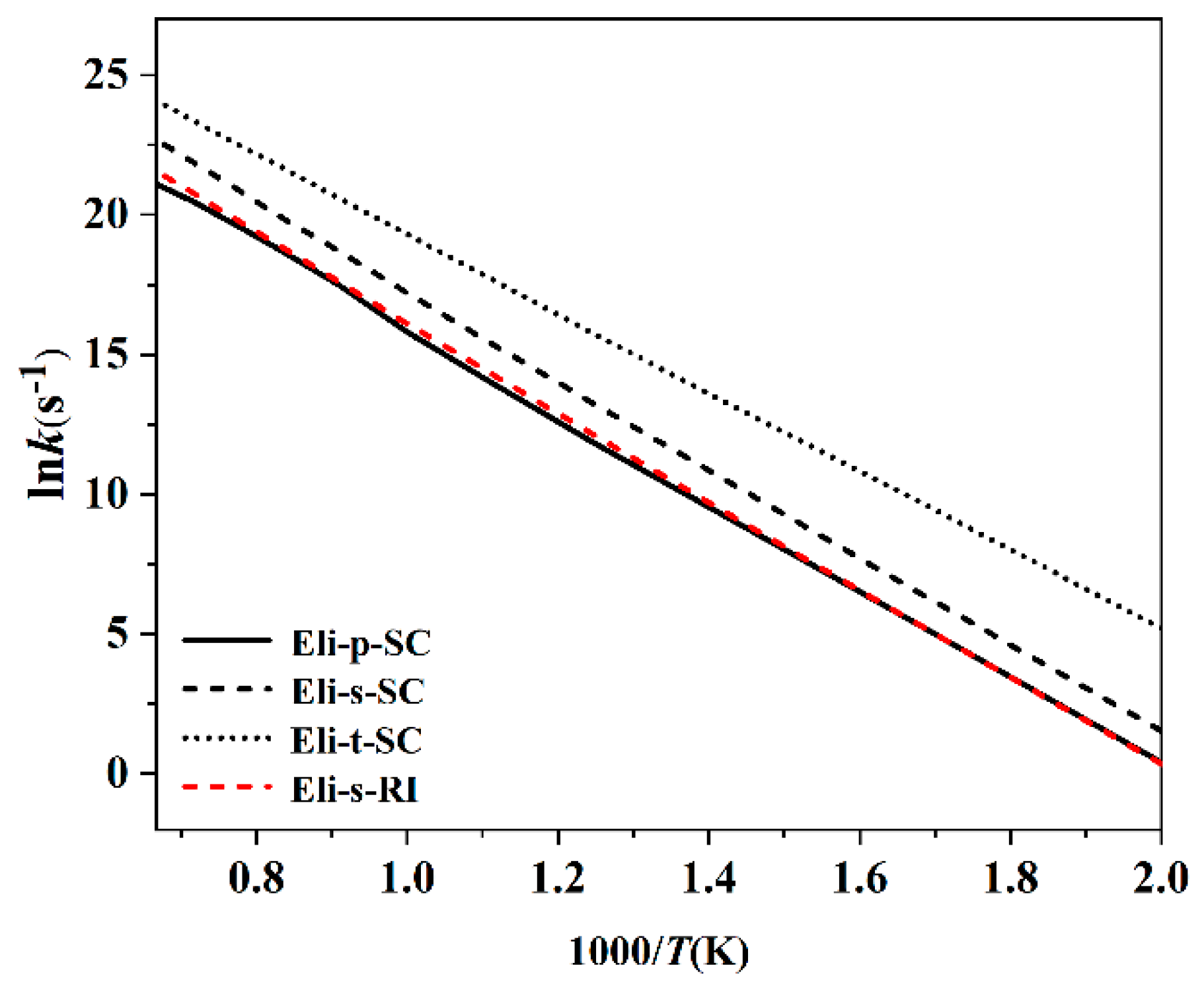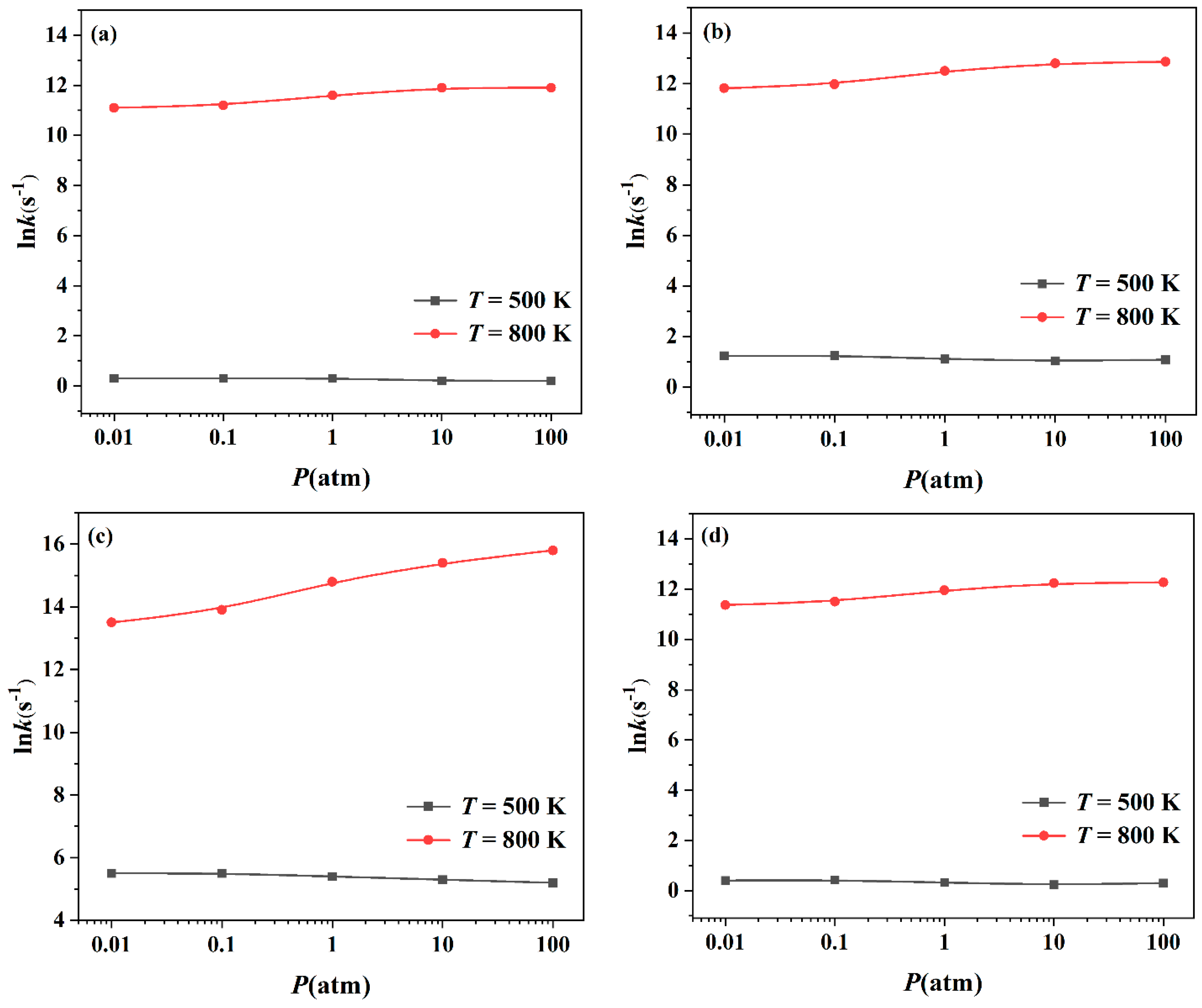A Theoretical Kinetic Study on Concerted Elimination Reaction Class of Peroxyl-hydroperoxyl-alkyl Radicals (•OOQOOH) in Normal-alkyl Cyclohexanes
Abstract
1. Introduction
2. Results and Discussion
2.1. Conformational Analysis
2.2. Energy Barrier
2.3. Energy Barrier Comparison with Similar Reactions in Alkanes
 ) calculated in this study is 29.8 kcal mol−1, which is much lower than the energy barrier of 33.7 kcal mol−1 for the analogous reaction (•OO(CH2)3OOH → CH2=CHCH2OOH + HO2•) calculated by Sun et al. The energy barrier of the reaction R8 (
) calculated in this study is 29.8 kcal mol−1, which is much lower than the energy barrier of 33.7 kcal mol−1 for the analogous reaction (•OO(CH2)3OOH → CH2=CHCH2OOH + HO2•) calculated by Sun et al. The energy barrier of the reaction R8 ( ) calculated in this work is 30.0 kcal mol−1, which is lower than the energy barrier of 32.9 kcal mol−1 for the analogous reaction (CH3CH (OO•)(CH2)2OOH → CH3CH=CHCH2OOH + HO2•) calculated by Sun et al. Goldsmith et al. [28] studied the kinetics of the C3H7O2 and C3H7O4 potential energy surfaces in high–level ab initio calculations, which also included the concerted HO2 elimination reactions of •OOCH2CH2CH2OOH and •OOCH2CH (OOH)CH3. The energy barrier of the reaction R5 (
) calculated in this work is 30.0 kcal mol−1, which is lower than the energy barrier of 32.9 kcal mol−1 for the analogous reaction (CH3CH (OO•)(CH2)2OOH → CH3CH=CHCH2OOH + HO2•) calculated by Sun et al. Goldsmith et al. [28] studied the kinetics of the C3H7O2 and C3H7O4 potential energy surfaces in high–level ab initio calculations, which also included the concerted HO2 elimination reactions of •OOCH2CH2CH2OOH and •OOCH2CH (OOH)CH3. The energy barrier of the reaction R5 ( ) calculated in this work is 29.8 kcal mol−1, which is lower than the energy barrier of 30.3 kcal mol−1 for the analogous reaction (•OOCH2CH2CH2OOH → CH2=CHCH2OOH + HO2•) calculated by Goldsmith et al. The results of comparisons show that the energy barriers for the reactions in different types of the concerted elimination of •OOQOOH calculated in this study are obviously different from the analogous reactions in non-cyclic alkanes, indicating that the presence of rings in cyclohexane can influence the heights of the energy barriers.
) calculated in this work is 29.8 kcal mol−1, which is lower than the energy barrier of 30.3 kcal mol−1 for the analogous reaction (•OOCH2CH2CH2OOH → CH2=CHCH2OOH + HO2•) calculated by Goldsmith et al. The results of comparisons show that the energy barriers for the reactions in different types of the concerted elimination of •OOQOOH calculated in this study are obviously different from the analogous reactions in non-cyclic alkanes, indicating that the presence of rings in cyclohexane can influence the heights of the energy barriers.2.4. High-Pressure-Limit Rate Constants and Rate Rules
2.4.1. Comparison of the High-Pressure-Limit Rate Rules between Different Subclasses
2.4.2. Comparison of the High-Pressure-Limit Rate Constants with the Literature Values
2.5. Pressure-Dependent Rate Constants and Rate Rules
Comparison of the Pressure-Dependent Rate Rules at Different Pressures
3. Methods
3.1. Electronic Structure Calculation
3.2. Calculation of Rate Constant
4. Conclusions
Supplementary Materials
Author Contributions
Funding
Institutional Review Board Statement
Informed Consent Statement
Data Availability Statement
Conflicts of Interest
Sample Availability
References
- Violi, A.; Yan, S.; Eddings, E.G.; Sarofim, A.F.; Granta, S.; Faravelli, T.; Ranzi, E. Experimental formulation and kinetic model for JP-8 surrogate mixtures. Combust. Sci. Technol. 2002, 174, 399–417. [Google Scholar] [CrossRef]
- Yang, M.; Wang, J. Multi-structural variational kinetics study on hydrogen abstraction reactions of cyclopentanol and cyclopentane by hydroperoxyl radical with anharmonicity, recrossing and tunneling effects. Phys. Chem. Chem. Phys. 2023, 25, 12943. [Google Scholar] [CrossRef] [PubMed]
- Law, C.K. Combustion Physics; Cambridge University Press: Cambridge, UK, 2006. [Google Scholar]
- Stephen, R.T. An Introduction to Combustion: Concepts and Applications, 2nd ed.; McGraw-Hill: Singapore, 2000. [Google Scholar]
- Delfau, J.L.; Biet, J.; Idir, M.; Pillier, L.; Vovelle, C. Experimental and numerical study of premixed, lean ethylene flames. Proc. Combust. Inst. 2007, 31, 357–365. [Google Scholar] [CrossRef]
- Warnatz, J.; Maas, U.; Dibble, R.W. Combustion Physical and Chemical Fundamentals Modeling and Simulation, Experiments, Pollutant Formation, 3rd ed.; Springer: Berlin/Heidelberg, Germany, 2006. [Google Scholar]
- Mehl, M.; Vanhove, G.; Pitz, W.J.; Ranzi, E. Oxidation and combustion of the n-hexene isomers: Awide range kinetic modeling study. Combust. Flame 2008, 155, 756–772. [Google Scholar] [CrossRef][Green Version]
- Briker, Y.; Ring, Z.; Iacchelli, A.; McLean, N.; Rahimi, P.M.; Fairbridge, C.; Malhotra, R.; Coggiola, M.A.; Young, S.E. Diesel fuel analysis by GC n-paraffins, and isoparaffins. Energy Fuels 2001, 1, 23–37. [Google Scholar] [CrossRef]
- Edwards, T.; Maurice, L.Q. Surrogate mixtures to represent complex aviation and rocket fuels. J. Propul. Power 2001, 17, 461–466. [Google Scholar] [CrossRef]
- Farrell, J.T.; Cernansky, N.P.; Dryer, F.L.; Law, C.K.; Friend, D.G.; Hergart, C.A.; McDavid, R.M.; Patel, A.K.; Mueller, C.J.; Pitsch, H. Development of an Experimental Database and Kinetic Models for Surrogate Diesel Fuels; SAE Technical Papers; SAE International: Warrendale, PA, USA, 2007. [Google Scholar]
- Pitz, W.J.; Cernansky, N.P.; Dryer, F.L.; Egolfopoulos, F.N.; Farrell, J.T.; Friend, D.G.; Pitsch, H. Development of an Experimental Database and Chemical Kinetic Models for Surrogate Gasoline Fuels; SAE Technical Papers; SAE International: Warrendale, PA, USA, 2007. [Google Scholar]
- Gokulakrishnan, P.; Gaines, G.; Currano, J.; Klassen, M.S.; Roby, R.J. Experimental and kinetic modeling of kerosene-type fuels at gas turbine operating conditions. J. Eng. Gas Turb. Power 2006, 129, 655–663. [Google Scholar] [CrossRef]
- Kim, D.; Martz, J.; Violi, A. A surrogate for emulating the physical and chemical properties of conventional jet fuel. Combust. Flame 2014, 161, 1489–1498. [Google Scholar] [CrossRef]
- Li, H.; Qiu, Y.; Wu, Z.; Wang, S.; Lu, X.; Huang, Z. Ignition delay of diisobutylene-containing multicomponent gasoline surrogates: Shock tube measurements and modeling study. Fuel 2019, 23, 1387–1399. [Google Scholar] [CrossRef]
- Li, H.; Yu, L.; Sun, S.; Wang, S.; Lu, X.; Huang, Z. A shock tube experimental and modeling study of multicomponent gasoline surrogates diluted with exhaust gas recirculation. Energy Fuels 2018, 32, 3800–3813. [Google Scholar] [CrossRef]
- Narayanaswamy, K.; Pitsch, H.; Pepiot, P. A component library framework for deriving kinetic mechanisms for multi-component fuel surrogates: Application for jet fuel surrogates. Combust. Flame 2016, 165, 288–309. [Google Scholar] [CrossRef]
- Yu, W.; Yang, W.; Tay, K.; Zhao, F. An optimization method for formulating model-based jet fuel surrogate by emulating physical, gas phase chemical properties and threshold sooting index (TSI) of real jet fuel under engine relevant conditions. Combust. Flame 2018, 193, 192–217. [Google Scholar] [CrossRef]
- Law, M.E.; Westmoreland, P.R.; Cool, T.A.; Wang, J.; Hansen, N.; Taatjes, C.A.; Kasper, T. Benzene precursors and formation routes in a stoichiometric cyclohexane flame. Proc. Combust. Inst. 2007, 31, 565–573. [Google Scholar] [CrossRef]
- Wang, Z.D.; Zhang, L.D.; Moshammer, K.; Popolan-Vaida, D.M.; Shankar, V.S.B.; Lucassen, A.; Hemken, C.; Taatjes, C.A.; Leone, S.R.; Kohse-Höinghaus, K.; et al. Additional chain-branching pathways in the low-temperature oxidation of branched alkanes. Combust. Flame 2016, 164, 386–396. [Google Scholar] [CrossRef]
- Sun, X.H.; Yao, Q.; Li, Z.R.; Wang, J.B.; Li, X.Y. Calculation of the rate constants for concerted elimination reaction class of hydroperoxyl-alkyl-peroxyl radicals. Theor. Chem. Acc. 2017, 136, 64. [Google Scholar] [CrossRef]
- Pilling, M.J.; Hancock, G. Low Temperature Combustion and Autoignition; Elsevier: Amsterdam, The Netherlands, 1997. [Google Scholar]
- Androulakis, I.P.; Grenda, J.M.; Barckholtz, T.A.; Bozzelli, J.W. Propagation of uncertainty in chemically activated systems. Aiche J. 2010, 52, 3246–3256. [Google Scholar] [CrossRef]
- Pilling, M.J. From elementary reactions to evaluated chemical mechanisms for combustion models. Proc. Combust. Inst. 2009, 32, 27–44. [Google Scholar] [CrossRef]
- Yao, Q.; Sun, X.H.; Li, Z.R.; Chen, F.F.; Li, X.Y. Pressure-dependent rate rules for intramolecular H-migration reactions of hydroperoxyalkylperoxy radicals in low temperature. J. Phys. Chem. A 2017, 121, 3001–3018. [Google Scholar] [CrossRef] [PubMed]
- Yao, X.X.; Wang, J.B.; Yao, Q.; Li, Y.Q.; Li, Z.R.; Li, X.Y. Pressure-dependent rate rules for intramolecular H-migration reactions of normal-alkyl cyclohexylperoxy radicals. Combust. Flame 2019, 204, 176–188. [Google Scholar] [CrossRef]
- Yao, X.X.; Pang, W.Q.; Li, T.; Shentu, J.T.; Li, Z.R.; Zhu, Q.; Li, X.Y. High-pressure-limit and pressure-dependent rate rules for unimolecular reactions related to hydroperoxy alkyl radicals in normal alkyl cyclohexane combustion. 1. concerted HO2 elimination reaction class and β-scission reaction class. J. Phys. Chem. A 2021, 125, 8942–8958. [Google Scholar] [CrossRef]
- Yao, X.X.; Pang, W.Q.; Li, T.; Shentu, J.T.; Li, Z.R.; Zhu, Q.; Li, X.Y. High-pressure-limit and pressure-dependent rate rules for unimolecular reactions related to hydroperoxy alkyl radicals in normal-alkyl cyclohexane combustion. 2. cyclization reaction class. J. Phys. Chem. A 2021, 125, 8959–8977. [Google Scholar] [CrossRef] [PubMed]
- Goldsmith, C.F.; Green, W.H.; Klippenstein, S.J. Role of O2 + QOOH in low-temperature ignition of propane. 1. temperature and pressure dependent rate coeffcients. J. Phys. Chem. A 2012, 116, 3325–3346. [Google Scholar] [CrossRef]
- Zou, J.B.; Zhang, X.Y.; Li, Y.Y.; Ye, L.L.; Xing, L.L.; Li, W.; Cao, C.C.; Zhai, Y.T.; Qi, F.; Yang, J.Z. Experimental and kinetic modeling investigation on ethylcyclohexane low-temperature oxidation in a jet-stirred reactor. Combust. Flame 2020, 214, 211–223. [Google Scholar] [CrossRef]
- Villano, S.M.; Huynh, L.K.; Carstensen, H.H.; Dean, A.M. High-pressure rate rules for alkyl + O2 reactions. 1. The dissociation, concerted elimination, and isomerization channels of the alkyl peroxy radical. J. Phys. Chem. A 2011, 115, 13425–13442. [Google Scholar] [CrossRef] [PubMed]
- Fernandes, R.X.; Zador, J.; Jusinski, L.E.; Miller, J.A.; Taatjes, C.A. Formally direct pathways and low-temperature chain branching in hydrocarbon autoignition: The cyclohexyl + O2 reaction at high pressure. Phys. Chem. Chem. Phys. 2009, 11, 1320–1327. [Google Scholar] [CrossRef]
- Xing, L.L.; Zhang, L.D.; Zhang, F.; Jiang, J. Theoretical kinetic studies for low temperature oxidation of two typical methylcyclohexyl radicals. Combust. Flame 2017, 182, 216–224. [Google Scholar] [CrossRef]
- Xing, L.L.; Zhang, F.; Zhang, L.D. Theoretical studies for reaction kinetics of cyC6H11CH2 radical with O2. Proc. Combust. Inst. 2015, 36, 179–186. [Google Scholar] [CrossRef]
- Mao, Y.B.; Wang, S.X.; Wu, Z.Y.; Qiu, Y.; Yu, L.; Ruan, C.; Chen, F.; Zhu, L.; Lu, X.C. An experimental and kinetic modeling study of n-butylcyclohexane over low-to-high temperature ranges. Combust. Flame 2019, 206, 83–97. [Google Scholar] [CrossRef]
- Natelson, R.H.; Kurman, M.S.; Cernansky, N.P.; Miller, D.L. Low temperature oxidation of n-butylcyclohexane. Combust. Flame 2011, 158, 2325–2337. [Google Scholar] [CrossRef]
- Mao, Y.; Li, A.; Zhu, L.; Wu, Z.; Yu, L.; Wang, S.; Raza, M.; Lu, X. A detailed chemical mechanism for low to high temperature oxidation of n-butylcyclohexane and its validation. Combust. Flame 2019, 210, 360–373. [Google Scholar] [CrossRef]
- Liu, M.X.; Fang, R.Z.; Sung, C.J.; Aljohani, K.; Farooq, A.; Almarzooq, Y.; Mathieu, O.; Petersen, E.L.; Dagaut, P.; Zhao, J.; et al. A comprehensive experimental and modeling study of n-propylcyclohexane oxidation. Combust. Flame 2022, 238, 111944. [Google Scholar] [CrossRef]
- Frisch, M.J.; Trucks, G.W.; Schlegel, H.B.; Scuseria, G.E.; Robb, M.A.; Cheeseman, J.R.; Scalmani, G.; Barone, V.; Mennucci, B.; Petersson, G.A.; et al. Gaussian 16, Revision C. 01; Gaussian, Inc.: Wallingford, CT, USA, 2016. [Google Scholar]
- Gonzalez, C.; Schlegel, H.B. An improved algorithm for reaction path following. J. Chem. Phys. 1989, 90, 2154–2161. [Google Scholar] [CrossRef]
- Montgomery, J.A.; Frisch, M.J.; Ochterski, J.W.; Petersson, G.A. A complete basis set model chemistry. VI. Use of density functional geometries and frequencies. J. Chem. Phys. 1999, 110, 2822–2827. [Google Scholar] [CrossRef]
- Mokrushin, V.; Tsang, W. Chemrate v.1.5.8; National Institute of Standards and Technology: Gaithersburg, MD, USA, 2009.
- Laidler, K.J.; King, M.C. Development of transition-state theory. J. Phys. Chem. 1983, 87, 2657–2664. [Google Scholar] [CrossRef]
- Truhlar, D.G.; Garrett, B.C.; Klippenstein, S.J. Current Status of Transition-State Theory. J. Phys. Chem. 1996, 100, 12771–12800. [Google Scholar] [CrossRef]
- Gilbert, R.G.; Smith, S.C. Theory of Unimolecular and Recombination Reactions; Blackwell: Oxford, UK, 1990. [Google Scholar]
- Wang, H.; Frenklach, M. Transport properties of polycyclic aromatic hydrocarbons for flame modeling. Combust. Flame 1994, 96, 163–170. [Google Scholar] [CrossRef]
- Eckart, C. The penetration of a potential barrier by electrons. Phys. Rev. 1930, 35, 1303–1309. [Google Scholar] [CrossRef]
- Johnston, H.S.; Heicklen, J. Tunnelling corrections for unsymmetrical Eckart potential energy barriers. J. Phys. Chem. 1962, 66, 532–533. [Google Scholar] [CrossRef]
- Klippenstein, S.J.; Pande, V.S.; Truhlar, D.G. Chemical kinetics and mechanisms of complex systems: A perspective on recent theoretical advances. J. Am. Chem. Soc. 2014, 136, 528–546. [Google Scholar] [CrossRef]
- Pitzer, K.S.; Gwinn, W.D. Energy levels and thermodynamic functions for molecules with internal rotation I. Rigid frame with attached tops. J. Chem. Phys. 1942, 10, 428–440. [Google Scholar] [CrossRef]
- Mammen, M.; Shakhnovich, E.I.; Whitesides, G.M. Using a convenient, quantitative model for torsional entropy to establish qualitative trends for molecular processes that restrict conformational freedom. J. Org. Chem. 1998, 63, 3168–3175. [Google Scholar] [CrossRef]
- CHEMKIN-PRO 15092; Reaction Design: San Diego, CA, USA, 2009.










| Subclass | Reaction | Energy Barrier | |
|---|---|---|---|
| Eli-p-SC | R1 |  | 32.3 |
| R2 |  | 29.3 | |
| R3 |  | 31.0 | |
| R4 |  | 32.5 | |
| (31.3 a, 3.2 b) | |||
| Eli-s-SC | R5 |  | 29.8 |
| R6 |  | 28.9 | |
| R7 |  | 30.8 | |
| R8 |  | 30.0 | |
| R9 |  | 29.0 | |
| R10 |  | 30.6 | |
| R11 |  | 30.7 | |
| R12 |  | 30.5 | |
| R13 |  | 28.8 | |
| R14 |  | 31.8 | |
| R15 |  | 31.6 | |
| R16 |  | 31.5 | |
| (30.3 a, 3.0 b) | |||
| Eli-t-SC | R17 |  | 26.7 |
| R18 |  | 26.8 | |
| R19 |  | 26.8 | |
| R20 |  | 26.6 | |
| (26.7 a, 0.2 b) |
| Subclass | Reaction | Energy Barrier | |
|---|---|---|---|
| Eli-s-RI | R21 |  | 29.4 |
| R22 |  | 32.5 | |
| R23 |  | 31.6 | |
| R24 |  | 31.0 | |
| R25 |  | 30.8 | |
| R26 |  | 30.8 | |
| R27 |  | 31.6 | |
| R28 |  | 31.9 | |
| R29 |  | 31.3 | |
| R30 |  | 31.0 | |
| R31 |  | 30.9 | |
| R32 |  | 32.2 | |
| R33 |  | 31.5 | |
| R34 |  | 29.4 | |
| R35 |  | 31.4 | |
| R36 |  | 31.0 | |
| R37 |  | 30.9 | |
| R38 |  | 31.6 | |
| R39 |  | 31.5 | |
| R40 |  | 31.8 | |
| R41 |  | 31.4 | |
| R42 |  | 32.8 | |
| R43 |  | 30.9 | |
| R44 |  | 32.2 | |
| (31.3 a, 3.4 b) |
| Modified Arrhenius Parameters | T = 800 K | ||||
|---|---|---|---|---|---|
| Reaction | A (s−1) | n | E (cal mol−1) | k (s−1) | k/kave e |
| R1 | 4.93 × 107 | 1.81 | 30,533.6 | 4.0 × 104 | 0.3 |
| R2 | 2.05 × 108 | 1.43 | 28,588.6 | 4.2 × 105 | 3.1 |
| R3 | 7.84 × 109 | 1.09 | 30,111.4 | 6.9 × 104 | 0.5 |
| R4 | 3.79 × 1056 | −13.32 | 49,803.3 | 2.2 × 104 | 0.2 |
| Eli-p-SC rate rule | 1.57 × 108 | 1.64 | 28,481.2 | 1.4 × 105 | 19.1 # |
| R5 | 3.79 × 108 | 1.74 | 28,497.1 | 6.9 × 105 | 1.4 |
| R6 | 2.57 × 108 | 1.67 | 27,626.4 | 5.3 × 105 | 1.0 |
| R7 | 4.00 × 109 | 1.68 | 29,468.1 | 2.8 × 106 | 5.2 |
| R8 | 1.86 × 1010 | 1.19 | 29,349.6 | 5.3 × 105 | 1.0 |
| R9 | 2.47 × 1010 | 1.20 | 29,350.9 | 7.0 × 105 | 1.3 |
| R10 | 5.18 × 1011 | 0.52 | 30,599 | 7.1 × 104 | 0.1 |
| R11 | 7.74 × 1011 | 0.52 | 30,600 | 1.1 × 105 | 0.2 |
| R12 | 2.16 × 1010 | 1.19 | 29,866.6 | 4.2 × 105 | 0.8 |
| R13 | 4.12 × 1010 | 0.98 | 28,308.2 | 5.4 × 105 | 1.0 |
| R14 | 1.11 × 1011 | 0.61 | 31,317.3 | 1.8 × 104 | 0.03 |
| R15 | 1.25 × 1010 | 0.78 | 30,983.5 | 8.1 × 103 | 0.02 |
| R16 | 3.49 × 108 | 1.43 | 30,593.3 | 2.2 × 104 | 0.04 |
| Eli-s-SC rate rule | 2.60 × 1010 | 1.08 | 30,836.8 | 5.3 × 105 | 24.4 # |
| R17 | 2.80 × 108 | 1.57 | 25,706.1 | 9.8 × 105 | 0.1 |
| R18 | 5.47 × 109 | 1.42 | 26,183 | 5.1 × 106 | 0.8 |
| R19 | 8.18 × 109 | 1.42 | 26,184.1 | 7.6 × 106 | 1.1 |
| R20 | 1.20 × 1013 | 0.47 | 26,879.2 | 1.3 × 107 | 1.9 |
| Eli-t-SC rate rule | 8.58 × 1010 | 1.06 | 26,361.1 | 6.6 × 106 | 13.1 # |
| Modified Arrhenius Parameters | T = 800 K | ||||
|---|---|---|---|---|---|
| Reaction | A (s−1) | n | E (cal mol−1) | k (s−1) | k/kave e |
| R21 | 1.51 × 1012 | 0.51 | 29,246.6 | 4.6 × 105 | 2.6 |
| R22 | 6.39 × 108 | 1.42 | 27,224.4 | 3.1 × 105 | 1.7 |
| R23 | 4.89 × 1010 | 1.01 | 30,984.9 | 1.4 × 105 | 0.8 |
| R24 | 1.27 × 1011 | 0.79 | 30,377.0 | 1.3 × 105 | 0.7 |
| R25 | 5.33 × 1010 | 0.80 | 30,115.3 | 6.4 × 104 | 0.4 |
| R26 | 5.22 × 1010 | 0.80 | 30,107.6 | 6.4 × 104 | 0.4 |
| R27 | 2.44 × 109 | 1.46 | 30,788.5 | 1.6 × 105 | 0.9 |
| R28 | 4.58 × 105 | 2.18 | 30,452.6 | 4.6 × 103 | 0.03 |
| R29 | 1.55 × 1011 | 0.90 | 30,708.6 | 2.5 × 105 | 1.4 |
| R30 | 4.57 × 1010 | 0.81 | 30,372.2 | 5.1 × 104 | 0.3 |
| R31 | 2.78 × 108 | 1.60 | 29,764.3 | 8.9 × 104 | 0.5 |
| R32 | 6.66 × 1010 | 0.91 | 31,607 | 6.7 × 104 | 0.4 |
| R33 | 5.56 × 1012 | 0.54 | 31,618.5 | 4.6 × 105 | 2.6 |
| R34 | 1.51 × 1012 | 0.51 | 29,246.6 | 4.6 × 105 | 2.6 |
| R35 | 4.60 × 106 | 1.94 | 30,292 | 1.0 × 104 | 0.1 |
| R36 | 3.56 × 1011 | 0.50 | 30,800.5 | 3.9 × 104 | 0.2 |
| R37 | 1.16 × 1012 | 0.52 | 30,713.4 | 1.6 × 105 | 0.9 |
| R38 | 2.60 × 1010 | 1.08 | 30,836.8 | 1.3 × 105 | 0.8 |
| R39 | 2.34 × 1012 | 0.73 | 31,431.1 | 7.9 × 105 | 4.5 |
| R40 | 6.75 × 1010 | 0.95 | 31,069.9 | 1.3 × 105 | 0.7 |
| R41 | 6.38 × 1010 | 0.97 | 30,914.1 | 1.5 × 105 | 0.8 |
| R42 | 2.72 × 1010 | 0.99 | 31,994.3 | 3.7 × 104 | 0.2 |
| R43 | 8.30 × 108 | 1.27 | 30,107 | 2.3 × 104 | 0.1 |
| R44 | 3.11 × 109 | 1.38 | 31,484.1 | 7.8 × 104 | 0.4 |
| Eli-s-RI rate rule | 2.40 × 109 | 1.35 | 29,501.2 | 1.8 × 105 | 30.0 # |
| Modified Arrhenius Parameters | T = 800 K | |||||
|---|---|---|---|---|---|---|
| Reaction | Pressure (atm) | A (s−1) | n | E (cal mol−1) | k (s−1) | k/kave e |
| Eli-p-SC rate rule | 0.01 | 4.60 × 1054 | −12.97 | 44,652.8 | 6.5 × 104 | 8.1 # |
| 0.1 | 4.34 × 1053 | −12.57 | 44,825.9 | 7.4 × 104 | 9.3 # | |
| 1 | 4.10 × 1039 | −8.13 | 40,143.2 | 1.1 × 105 | 13.2 # | |
| 10 | 1.91 × 1033 | −6.07 | 38,490.7 | 1.4 × 105 | 17.2 # | |
| 100 | 3.90 × 1019 | −1.86 | 33,084.3 | 1.4 × 105 | 18.7 # | |
| Eli-s-SC rate rule | 0.01 | 7.66 × 1059 | −14.54 | 46,136.0 | 1.4 × 105 | 31.1 # |
| 0.1 | 2.50 × 1053 | −12.49 | 43,974.3 | 1.6 × 105 | 14.6 # | |
| 1 | 3.07 × 1049 | −11.07 | 43,941.0 | 2.7 × 105 | 21.4 # | |
| 10 | 2.31 × 1042 | −8.75 | 42,013.0 | 3.6 × 105 | 27.0 # | |
| 100 | 1.48 × 1027 | −4.05 | 36,249.4 | 3.9 × 105 | 30.1 # | |
| Eli-t-SC rate rule | 0.01 | 6.43 × 1054 | −13.30 | 37,835.8 | 7.4 × 105 | 4.2 # |
| 0.1 | 7.17 × 1046 | −10.71 | 35,555.7 | 1.1 × 106 | 4.8 # | |
| 1 | 6.74 × 1054 | −12.82 | 40,914.0 | 2.7 × 106 | 6.2 # | |
| 10 | 8.99 × 1050 | −11.38 | 41,058.3 | 5.1 × 106 | 7.9 # | |
| 100 | 4.00 × 1040 | −8.03 | 38,136.5 | 7.4 × 106 | 11.3 # | |
| Eli-s-RI rate rule | 0.01 | 1.57 × 1060 | −14.59 | 47,219.6 | 8.6 × 104 | 13.9 # |
| 0.1 | 4.79 × 1053 | −12.53 | 45,013.8 | 9.9 × 104 | 16.4 # | |
| 1 | 9.77 × 1045 | −9.99 | 43,234.3 | 1.6 × 105 | 25.0 # | |
| 10 | 8.58 × 1039 | −8.00 | 41,735.5 | 2.1 × 105 | 34.2 # | |
| 100 | 7.40 × 1024 | −3.36 | 35,886.8 | 2.1 × 105 | 36.6 # | |
Disclaimer/Publisher’s Note: The statements, opinions and data contained in all publications are solely those of the individual author(s) and contributor(s) and not of MDPI and/or the editor(s). MDPI and/or the editor(s) disclaim responsibility for any injury to people or property resulting from any ideas, methods, instructions or products referred to in the content. |
© 2023 by the authors. Licensee MDPI, Basel, Switzerland. This article is an open access article distributed under the terms and conditions of the Creative Commons Attribution (CC BY) license (https://creativecommons.org/licenses/by/4.0/).
Share and Cite
Yao, X.; Zhang, J.; Zhu, Y. A Theoretical Kinetic Study on Concerted Elimination Reaction Class of Peroxyl-hydroperoxyl-alkyl Radicals (•OOQOOH) in Normal-alkyl Cyclohexanes. Molecules 2023, 28, 6612. https://doi.org/10.3390/molecules28186612
Yao X, Zhang J, Zhu Y. A Theoretical Kinetic Study on Concerted Elimination Reaction Class of Peroxyl-hydroperoxyl-alkyl Radicals (•OOQOOH) in Normal-alkyl Cyclohexanes. Molecules. 2023; 28(18):6612. https://doi.org/10.3390/molecules28186612
Chicago/Turabian StyleYao, Xiaoxia, Jilong Zhang, and Yifei Zhu. 2023. "A Theoretical Kinetic Study on Concerted Elimination Reaction Class of Peroxyl-hydroperoxyl-alkyl Radicals (•OOQOOH) in Normal-alkyl Cyclohexanes" Molecules 28, no. 18: 6612. https://doi.org/10.3390/molecules28186612
APA StyleYao, X., Zhang, J., & Zhu, Y. (2023). A Theoretical Kinetic Study on Concerted Elimination Reaction Class of Peroxyl-hydroperoxyl-alkyl Radicals (•OOQOOH) in Normal-alkyl Cyclohexanes. Molecules, 28(18), 6612. https://doi.org/10.3390/molecules28186612







